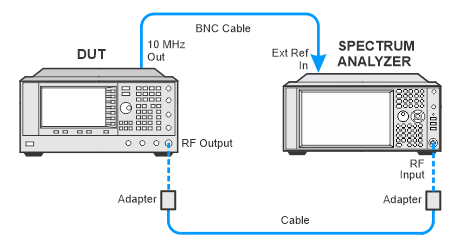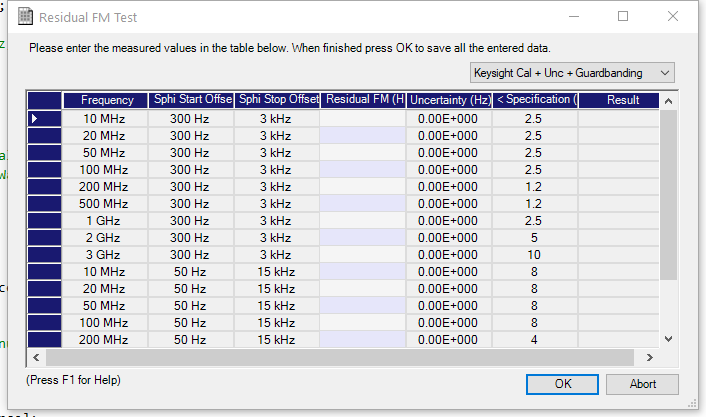For the E8663D Option HE3 PSG-D, a Phase Noise Test System is used to measure the Residual FM by taking a single sideband phase noise measurement of the DUT. The area under the phase noise plot between 300 Hz and 3 kHz or 50 Hz and 15 kHz is the Residual FM. If the DUT fails, it may be due to the DUT phase noise specifications being better than the reference source. (For information on performing a three-source measurement, click here.)
Required Test Equipment
|
Test Equipment
|
Recommended Models
|
Alternate Model(s)
|
|
Phase Noise System
|
N5511A Options 540, CH21
- CH2 is not required but recommended for future capability.
|
E5505A
E5504A/B
E5503A/B
|
|
Reference Source
|
E8663D Opt HY2
- Option HE3 is also allowed since it includes Option HY2.
|
|
Connections and Setup Procedures for a Manual Residual FM Measurement
There are two sets of procedures depending on the model of the phase noise test system used:
Select from the links below according to the phase noise test system being used.
N5511A PNTS,  click here.
click here.
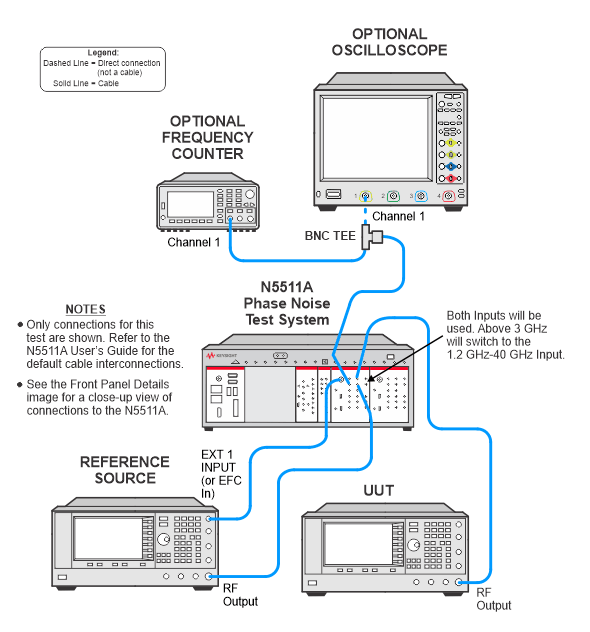
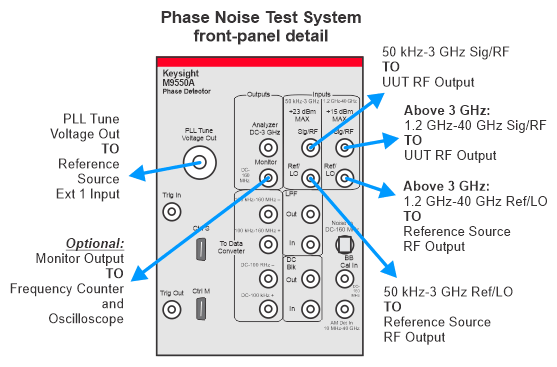
-
Connect
all test equipment as shown.
-
Connect
GPIB cables to all GPIB-controlled test equipment.
-
Preset
all test equipment and the DUT.
-
Change the following parameters in
the :
-
Select the View
pull-down menu.
-
Select Display
Preferences and un-check the Spurs box.
-
Select OK
to close Display Preferences.
-
Select the System pull-down menu and select Server Hardware Connections.
-
Select or ensure the following:
- Test Set has Keysight M9550A selected.
-
FFT Analyzer has Keysight M9551A selected.
-
Select Close to close Server Hardware Connections.
-
Select the Define
pull-down menu, select Measurement, and select the
following settings:
|
Parameter
|
Setting
|
|
|
|
|
Type and Range Tab
|
|
Measurement Type
|
Absolute phase noise (using a phase locked loop)
|
|
Measurement Method
|
Fast
|
|
Start Offset Resolution Expansion
|
10
|
|
Channel Setup
|
Single
|
|
Start Offset Frequency
|
290 Hz (must be < 300 Hz)
|
|
Stop Offset Frequency
|
3.1 kHz (must be > 3 kHz)
|
|
FFT Analyzer Minimum Number of Trace Averages
|
4
|
|
RBW %
|
1.96 (1024 point FFT)
|
|
FFT Overlap %
|
75
|
|
FFT Window Type
|
Flat Top
|
|
|
|
|
Sources Tab
|
|
Carrier Source Frequency
|
Obtain tested frequencies from the TME data entry form.
|
|
Carrier Source Power
|
+10 dBm
|
|
Detector Input Frequency
|
Same as Carrier Source Frequency
|
|
Reference Source Power
|
+15 dBm to 3 GHz
+10 dBm > 3 GHz
|
|
VCO Nominal Tune Constant
|
0.1 ppm x carrier source frequency
|
|
VCO Tune Range
|
5 Volts
|
|
VCO Input Resistance
|
50 Ω
|
|
Center Voltage
|
0 V
|
|
|
|
|
Cal Tab
|
|
Phase Detector Constant
|
Derive detector constant from measured beat note
|
|
VCO Tune Constant
|
Measure VCO Tune Constant
|
|
Verify calculated phase lock loop suppression
|
Blank
|
|
|
|
|
Block Diagram Tab
|
|
Carrier Source
|
Manual
|
|
Reference Source
|
Model number of reference source
|
|
Phase Detector
|
Automatic Detector Selection
|
|
Test Set Tune Voltage Output
|
Front Panel
|
|
Test Set Tune Voltage Destination
|
Reference Source
|
|
VCO Tune Mode
|
DCFM
|
|
|
|
|
Test Set Tab
|
|
LNA Low Pass Filter
|
Internal — Selected
Auto — Checked
|
|
LNA Gain
|
Auto Gain — Selected
Minimum Auto Gain — 14 dB
|
|
PLL Integrator Attenuation
|
0 dB
|
|
Use Channel #2
|
Unchecked
|
|
|
|
|
Graph Tab
|
|
Title
|
User specified
|
|
Graph Type
|
Spectral Density of Phase Fluctuations (dB/Hz)
|
|
X Scale minimum
|
Same as start offset frequency
|
|
X Scale maximum
|
Same as stop offset frequency
|
|
Y Scale maximum
|
0 dB/Hz
|
|
Y Scale minimum
|
–170 dB/Hz
|
|
Normalize Trace Data
|
1 Hz bandwidth
|

Making
the Measurement
-
Set
the DUT frequency to the first carrier frequency and power in the TME data entry form.
-
Set
the DUT RF Output to On.
-
Perform a phase noise measurement.
-
Place markers on the Sφ(f) plot at 300 Hz and 3 kHz.
Note that the E8663D HE3 also tests with the markers set at 50 Hz and 15 kHz. Use a start offset of 49 Hz and a stop offset of 15 kHz.
When specifying a marker offset, the marker will be set to the closest frequency on the graph as indicated in the following table:
|
Nominal Offset
|
Actual Offset
|
|
50 Hz
|
49.918 Hz
|
|
300 Hz
|
299.54 Hz
|
|
3 kHz
|
3.0034 kHz
|
|
15 kHz
|
14.974 kHz
|
-
Click on the Analyze pull-down menu and select Trace Integration.
-
Use the following settings:
|
Parameter
|
Actual Offset
|
|
Data Type
|
Snu(f) (Spectral density of frequency fluctuations)
|
|
CCIT Weighting
|
checked
|
|
Start Offset
|
Same as start offset frequency
|
|
Stop Offset
|
Same as stop offset frequency
|
|
Data to Integrate
|
Noise
|
-
Click on the Integrate field and read the Residual FM value from under the Value of definite integral.
-
Enter the Residual FM value into the TME user interface for Residual FM and compare it to the specification.
-
Repeat steps 1 through 8 for each frequency test point through 3 GHz.
-
For test points > 3 GHz, a connection change is required.
-
Connect the UUT RF Output to the 1.2 GHz to 40 GHz Sig/RF Input of the M9550A Phase Detector module in the N5511A PNTS.
-
Connect the Reference Source Output to the 1.2 GHz to 40 GHz Ref/LO Input of the M9550A Phase Detector module in the N5511A PNTS.
-
Repeat steps 1 through 8 for each frequency test point > 3 GHz.
For E5505A, E5504A/B, and E5503A/B legacy phase noise test system,  click here.
click here.
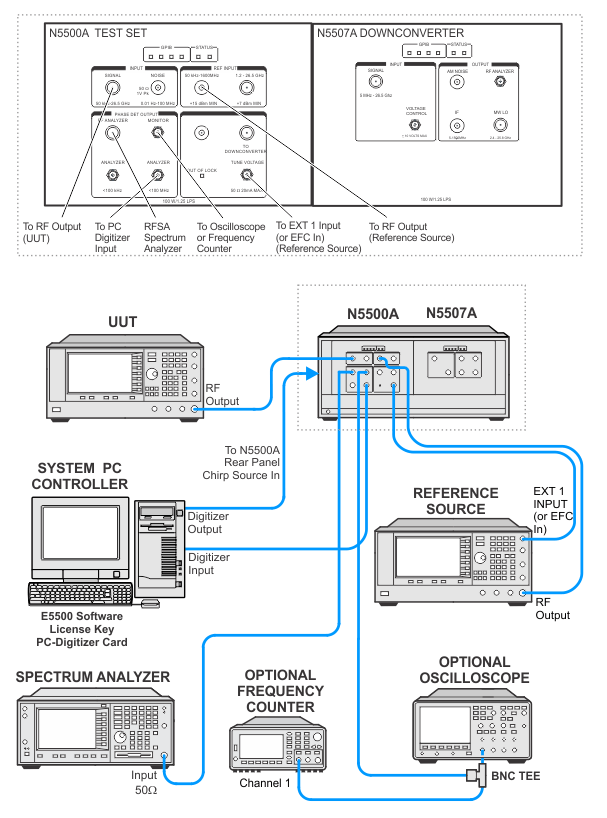

-
Connect
all test equipment as shown.
-
Connect
GPIB cables to all GPIB-controlled test equipment.
-
Preset
all test equipment and the DUT.
-
Set the DUT to the following settings:
|
DUT Settings
|
Manual Procedure
|
|
SNR mode On
|
Preset the DUT sets the SNR mode On.
To do this, perform the following steps:
- Press Amplitude > More > More > Optimize S/N Off On and select On.
- Press Frequency > More > RF Path and select Low Phase Noise.
-
Press Frequency > More > Low Pass Filter Below 2 GHz and select On.
|
|
Modulation mode Off
|
Press Mod On/Off > select Off.
|
-
In the E5505A Phase Noise System user interface, change the following parameters:
-
Select the View
pull-down menu.
-
Select Display
Preferences and un-check the Spurs box.
-
Select OK
to close Display Preferences.
-
Select the System
pull-down menu and select Server Hardware Connections.
-
Select or ensure that
the FFT Analyzer has NI PCI6111-1, 11 PCI20428W-1, or 89410A selected.
-
Select Close to close Server Hardware Connections.
-
Select the Define
pull-down menu, select Measurement, and select the
following settings:
|
Table 1: E8663D Option HE3 Test Frequency and Power
|
|
Frequency (MHz)
|
DUT Power (dBm)
|
|
10
|
+10
|
|
20
|
+10
|
|
50
|
+10
|
|
100
|
+10
|
|
200
|
+10
|
|
500
|
+10
|
|
1000
|
+10
|
|
2000
|
+10
|
|
3000
|
+10
|
|
Parameter
|
Setting
|
|
|
|
|
Type and Range Tab
|
|
|
Measurement Type
|
Absolute phase noise (using a phase locked loop)
|
|
Start Offset Frequency
|
10 Hz
|
|
Stop Offset Frequency
|
100 kHz
|
|
FFT Averages
|
4
|
|
FFT Quality
|
High Resolution
|
|
Swept Quality
|
Normal
|
|
|
|
|
Sources Tab
|
|
|
Carrier Source Connected
|
Test Set
|
|
Carrier Source Frequency
|
See Table 1 above
|
|
Carrier Source Power
|
See Table 1 above
|
|
Detector Input Frequency
|
Same as carrier source frequency
|
|
Reference Source Power
|
+16 dBm to 250 MHz, +10 dBm > 250 MHz
|
|
Nominal Tune Constant
|
1 ppm x carrier source frequency
|
|
Nominal Tune Range
|
1 Volt
|
|
Input Resistance
|
50 ohms
|
|
Center Voltage
|
0 Volt
|
|
|
|
|
Cal Tab
|
|
|
Measure Phase Detector Constant
|
Checkmark
|
|
Measure VCO Tune Constant
|
Checkmark
|
|
Verify calculated phase lock loop suppression
|
Blank
|
|
Phase Lock Loop Suppression
|
Use theoretical value
|
|
|
|
|
Block Diagram Tab
|
|
|
Carrier Source
|
Manual
|
|
Down Converter
|
None
|
|
Reference Source
|
E8257D
|
|
Phase Detector Mode
|
Automatic Detector Selection
|
|
Test Set Tune Voltage Destination
|
Reference Source
|
|
VCO Tune Mode
|
DCFM
|
|
|
|
|
Test Set Tab
|
|
|
Input Attenuation
|
0 dB
|
|
LNA Low Pass Filter
|
Auto
|
|
LNA Gain
|
Auto Gain
|
|
PLL Integrator Attenuation
|
0 dB
|
|
|
|
|
Graph Tab
|
|
|
Title
|
User specific
|
|
Graph Type
|
Spectral Density of Phase Fluctuations (dB/Hz)
|
|
X Scale minimum
|
Same as start offset frequency
|
|
X Scale maximum
|
Same as start offset frequency
|
|
Y Scale maximum
|
0 dBm
|
|
Y Scale minimum
|
-170 dBm
|
|
Normalize Trace Data
|
1 Hz bandwidth
|

Making the Measurement
-
Set the DUT frequency to the first carrier frequency and power in Table 1 above.
-
Ensure the Optimize φ Noise is set to Optimize φ Noise Offset < 150 kHz (Mode 1). To do this, select Frequency > More > More > Optimize φ Noise.
-
Set the DUT RF Output to On.
-
Perform a phase noise measurement.
- If using a release of the phase noise measurement software older than A.04.05.0001, when the window appears, ensure the Input Impedance on the Reference Source’s Ext 1 Input is set to 50 Ohms. To do this, select FM/ φM > More > Ext Impedance and select 50 Ohm.
-
Place markers on the Sphi (f) plot at 300 Hz and 3 kHz, or 50 Hz and 15 kHz according to the Bandwidth tested.
-
Left mouse click on the Analyze pull-down menu and select Trace Integration.
|
Setup
|
|
Parameter
|
Setting
|
|
Data Type
|
Snu(f) (Spectral Density of Frquency Fluctuations)
|
|
Start Offset
|
300 Hz (for 300 Hz to 3 kHz Bandwidth)
50 Hz (for 50 Hz to 15 kHz Bandwidth)
|
|
Stop Offset
|
3 kHz (for 300 Hz to 3 kHz Bandwidth)
15 kHz (for 50 Hz to 15 kHz Bandwidth)
|
|
CCITT Weighting
|
Unchecked
|
|
Data to Integrate
Noise and Spurs
|
Checkmarked
|
-
Click on the Integrate field and read the Residual FM value from under the Value of definite integral.
-
Enter the Residual FM value into the TME user interface for Residual FM and compare it to the specification.
-
Make two integrations for 300 Hz to 3 kHz Bandwidth and 50 Hz to 15 kHz Bandwidth.
-
Continue to the next carrier setup and repeat the measurement. If the next carrier is > 1 GHz, then connect the reference generator signal to the 1.2 GHz to 26.5 GHz N5500A Reference input.
|

|
If a failure occurs, it may not be due to the signal generator. For some test conditions, the signal generator specifications are better than the reference source specifications. If a failure occurs, a three-source measurement should be performed at this carrier frequency to identify a true failure. (For information on performing a three-source measurement, click here.)
|
